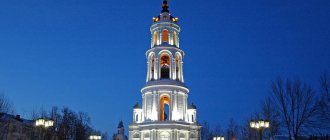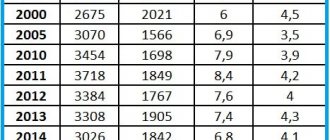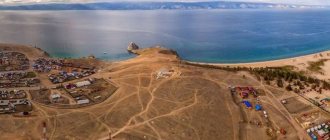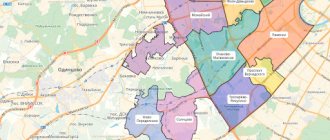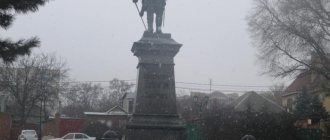Tomsk region is part of: Siberian Federal District, West Siberian economic region. Administrative center is the city of Tomsk. List of all Russian settlements in the Tomsk region (region 70). Catalog of cities, towns, villages within the regions of the region itself. Detailed articles on each locality, interesting facts.
Area: 314,391 km², Time zone: UTC+7:00, Population: 1,070,544 people. (2021), Density: 3.41 people/km², Russian Federation subject code: 70, Telephone code: 3822
What holiday is it today?
January 22, 2022, Saturday
Today are holidays, events: Day of Unification of Ukraine Tomorrow: Premiere of the opera “Eugene Onegin” at the Bolshoi Theater
Today is the Orthodox holiday: Martyr Polyeuctus. St. Philip, Metropolitan of Moscow and All Russia, wonderworker... Tomorrow: St. Gregory, Bishop of Nyssa. Venerable Markian the presbyter. Venerable Dometian, Bishop of Melitino. St. Paul of Komel, wonderworker, student of St. Sergius of Radonezh. Saint Theophan, the Recluse of Vyshensky...
Today is a national holiday: St. Philip's Day... Tomorrow: Gregory - Summer Guide...
Seasons
Seasons, four periods of the year (spring, summer, autumn and winter) characterized by certain average temperatures. The period during which the Sun passes through one of these sectors is called the season. Spring in the Northern Hemisphere and autumn in the Southern Hemisphere begin when the Sun passes through the initial circle of declination and its right ascension is 0° (vernal equinox). Summer in the Northern Hemisphere and winter in the Southern Hemisphere occur when the sun's right ascension is 90° (summer solstice). Autumn in the Northern Hemisphere and spring in the Southern Hemisphere begin when the sun's right ascension is 180° (autumnal equinox). The beginning of winter in the Northern Hemisphere and summer in the Southern Hemisphere is considered to be the winter solstice, when the direct ascension of the Sun is 270°... Next: Seasons. Russian folk calendar. Monthly words...
Content
- 1 General information
- 2 Geography 2.1 Rivers
- 2.2 Lakes
- 2.3 Vegetation
- 2.4 Climate
- 4.1 War 1941–1945 and post-war period
Tomsk region
- one of the constituent entities of the Russian Federation, located in the south of Western Siberia.
The administrative center of the region is the city of Tomsk
.
By decree of the Presidium of the Supreme Soviet of the USSR dated June 26, 1967, the Tomsk region was awarded the country's highest award, the Order of Lenin.
- for success in labor and production activities.
Folk calendar about every day
Every day one season always replaces another and this determines a person’s way of life. In connection with this, a folk calendar was formed in which there were practically no nameless, unmarked days. Every day was special, had its own purpose. All this was determined by climate conditions and astrological phenomena.
A calendar is a system for counting periods of time. The first calendars arose a long time ago, in ancient times, because there was a need to measure time. The word calendar comes from the Latin words caleo - to proclaim and calendarium - debt book. This is due to the fact that in Ancient Rome the beginning of each month was especially proclaimed, and because it was customary to pay debts on the first day of the month. Different peoples counted time differently. Some calendars are based on the changing phases of the moon - lunar calendars; in others - the change of seasons - sunny; in others, the length of the year was coordinated with the change of seasons, and the counting of months was associated with the phases of the Moon. Such calendars are called lunisolar.
In Rus', the calendar was called a monthly calendar. Every day, the month book covered the entire year of peasant life, “describing” day by day, month after month, where each day had its own holidays or weekdays, customs and superstitions, traditions and rituals, natural signs and phenomena. The cyclical nature of the calendar is reminiscent of human life, where spring is youth, summer is heyday, autumn is the time of harvesting fruits (it’s good if there are some, otherwise you can live your life without collecting fruits), winter is the time of wisdom and peace. This cyclicality and rhythm determined the way of life of the farmer. The folk calendar was an agricultural calendar, which was reflected in the names of the months, folk signs, rituals and customs. Even the determination of the timing and duration of the seasons is associated with real climatic conditions. Hence the discrepancy between the names of the months in different areas... Next: Folk calendar...
Links
- Official website of the Tomsk Region Administration
- Official website of the Tomsk Region Duma
- Detailed map of the Tomsk region
- Tomsk Region Book of Records
- Red Book of the Tomsk Region
- Photos of Tomsk region
- Peoples of the Tomsk region
- Visual and anthropological studies of small peoples in Western Siberia
- Tomsk region contributes 76% of taxes to the federal budget
- Matvienko: There is an insufficient level of income in the Tomsk region
- The tourist route in the Tomsk region received national status
| Administrative division of the Tomsk region | |
| Cities of regional subordination: Kedrovy, Seversk, Strezhevoy, Tomsk | |
| Cities of district subordination: Asino, Kolpashevo | |
| Districts (administrative centers in brackets): | |
|
|
Fishing calendar for every day
The fishing calendar should not be taken as an absolutely indisputable truth. Fish biting is greatly influenced by a whole range of natural factors, as well as the influence on the nature of man himself. You must not forget that the fish’s bite depends and is determined not only by the calendar dates and biological cycles of their life, reflected in the calendar, but also, no less, by the state of their habitat; the bite also depends on weather conditions: air and water temperatures, cloudiness, wind direction and strength, etc... Next: Fishing calendar...
National composition
The lion's share of local residents, according to the 2010 census, are Russian - more than 92%, or 922,723 people. The next largest nation is sharply inferior - only 1.7% of Tatars live here.
In third place, also noticeably behind, are the Ukrainians. At the time of the last census, just over 11 thousand Ukrainians lived here, or 1.12%.
There are also Germans here, and not so few of them - approximately 0.87%, or 8687 people.
Azerbaijanis close the top five peoples most common in the Tomsk region. In 2010, a little more than 2 thousand representatives of this people lived here, which is 0.4% of the total population.
In general, here you can see representatives of dozens of peoples, both local (Chulym, Yakut, Khanty) and very exotic for these places (Vietnamese, Yezidis, Jews, Greeks). Of course, the number of most of them is extremely limited and mostly amounts to only a few hundred people - less than 0.01%.
Such a varied composition is easy to explain. During Soviet times, industry actively developed here - both mining, manufacturing, and agriculture. Therefore, people came here from all over the Soviet Union - teachers, builders, geologists, doctors, drivers, workers and many, many others.
In post-Soviet times, the region began to concentrate on the extractive industry - primarily oil. Serious salaries attract many residents from other areas.
In recent years, the number of Chinese has increased sharply. Immigrants from China receive the right to logging or simply begin logging on their own. Of course, as a more understandable and cheaper labor force, influential and richer loggers prefer to use their compatriots, many of whom come without paperwork.
Alas, the area of the Tomsk region in km2 is about 314,000, and it is very difficult to control it. Therefore, it is unknown when the situation here will change and whether it will change at all.
Orthodox calendar about every day
Orthodox calendar: Orthodox, Church and Christian holidays.
The church year is an alternation of weekdays and holidays. On weekdays, a person is called to work “by the sweat of his brow to earn his bread.” Holidays are given in order to feel liberation, to rise above the bustle and routine of the world, to feel involved in the highest of worlds, “where there are no illnesses, sorrows and sighs, but endless life.” Since ancient times, holiday cycles have been associated with the seasons. The pagans associated them with the worship of the forces of nature, the cult of which in the Old Testament was replaced by gratitude to the Creator for the universe. And although the connection between holidays and the seasons has not completely lost its power, since God is present in everything, in the plant and animal world, in human works, it nevertheless faded into the background, giving way to a spiritual foundation built on the Sacred Scriptures. The history of Orthodox holidays dates back to the times of the Old Testament. Each of the Orthodox holidays is dedicated to the remembrance of the most important events in the life of Jesus Christ and the Mother of God, as well as the memory of saints... Next: Orthodox calendar...
Where is she located
It is located almost in the very center of Russia, with a slight shift to the south. In the east it borders with the Krasnoyarsk Territory. In the west - with the Tyumen and Omsk regions. From the south it is limited by the Novosibirsk and Kemerovo regions. Finally, from the north and northwest, the region surrounds the Khanty-Mansiysk Autonomous Okrug.
Located in the depths of the Eurasian continent, the region has a rather harsh climate - continental. Warm air masses from the west do not reach here, cut off by the Ural Mountains. Therefore, summers here are very hot, but winters can be quite harsh, snowy and cold. Needless to say, this is real Siberia in all its glory!
Russian folk calendar for every day
The word “sign” comes from the word “notice”, i.e. observe. As a result of observing what happens around a person every day, he accumulates life experience. This knowledge was passed down from generation to generation, carefully preserved and people trusted it as a sacred book. Many signs have come to us from the depths of centuries without losing their knowledge. Each of us is free to choose: to dismiss all this as an absurd superstition or to take a closer look at the signs and take the centuries-old experience of generations more seriously. Most of us, when taking exams, ask them to scold them, boasting about some kind of good fortune or luck, spit so as not to jinx them or knock on wood, take a detour if a black cat crossed the road, are afraid of the number 13 and much more. And who among us does not have lucky things, numbers? Who has never resorted to the help of fate at least once in their life, who has not believed in secrets? It’s as if everything connected with signs is hidden somewhere deep in our subconscious. Often we remember them mechanically, unconsciously, or just as a joke. But, undoubtedly, the signs contain a lot of accurate knowledge and practical wisdom of our ancestors. They cover all the characteristic, often difficult to perceive, natural phenomena. Signs have preserved a lot of what was in old folk holidays and customs; they help predict the weather, grow crops... Next: Folk signs...
total area
Now we can talk about the area and extent of the Tomsk region. From north to south it stretches for almost 600 kilometers. But from west to east – more than 780 kilometers. Thus, the area of the Tomsk region in sq. km is 314,391. By Russian standards, not too much - only 16th place among regions and other administrative units. But when compared with European countries, these sizes are very impressive. This is slightly larger than Poland - one of the largest states in Europe, 2.5 times larger than Greece, 3.5 times larger than Iceland. And about seven countries like Switzerland could fit here, and there would still be room for almost all of Moldova.
Most of this territory is occupied by forests - almost 63% of impenetrable, wild Taiga. Unfortunately, in recent years, forests have been rapaciously destroyed - mostly by Chinese entrepreneurs, who often do not have licenses to carry out logging.
There are a lot of swamps here - they account for almost a third of the territory of the Tomsk region. The area of the swamps is almost 91 thousand hectares.
The altitude above sea level is not too high - there are no large hills, not to mention mountains. The highest point is 274 meters above sea level, and the lowest is 34 meters.
Holiday calendar, dates and events of the year
All state and professional holidays in Russia, including significant World and International holidays, and other equally interesting holidays and events about every day.
The holiday has always kept pace with the history of mankind. Social time can be divided into three types: everyday life (weekdays), weekends and holidays. Everyday life is a series of practices repeated day after day and every day (work). Weekends are regular breaks from the rush of everyday life. It is believed that on weekends a person should restore his strength after working days. Day off, non-working day. A holiday is a day of celebration established in honor or in memory of someone or something. A day or series of days celebrated by the church in memory of a religious event or saint... Next: Calendar...
Interesting Facts
Now you know the area of the Tomsk region in hectares and square kilometers, you have an idea of its population, industry and history. You can cite several not so important, but quite interesting facts that will reveal this area and its center from a completely new, unexpected side.
Tomsk can boast of a large number of monuments, many of which are distinguished by their originality. So, while walking along the streets of the city, you can come across monuments to the ruble, cabbage, slippers, and beaver. But perhaps all of them are overshadowed by the monument depicting a wolf from the famous Soviet cartoon “Once upon a time there was a dog,” where the now catchphrase was uttered: “I’ll sing now!”
From the eighteenth century until the October Revolution, the Tomsk region was a place where political prisoners were sent. For example, in the first half of the nineteenth century, every fifth resident of these places was an exile.
Tomsk universities, which are the hallmark of the city, have produced such famous instructors as M. Mil (creator of the Mi series helicopters), N. Kamov (helicopter developer), N. Nikitin (architect who designed the Ostankino TV tower).
Mikhail Andreev, who composed the song “Poplar fluff, heat, July,” which was a real hit for several years, played on radio and television, was inspired by the landscapes of this particular glorious city. In addition, he wrote the song “Tram Pyaterochka”. True, this text had to be edited a little later. The fact is that it featured a rather unusual name for the local district - Cheremoshniki. The toponym is unusual, so it was replaced with Cheryomushki - such areas exist in many cities of the country, so preference was given to the popular option. But from Cheremoshniki it was really possible to get to the city center by tram route No. 5, until it was abolished.
Prayer book, Orthodox prayers for every day
Prayer is the most powerful means for healing all illnesses - both physical and mental. Prayers can be laudatory or grateful, petitionary and repentant. If we have offended God, sinned, we must ask Him for forgiveness, that is, repent. Such prayers are called repentant prayers. If everything is fine with us, if we and our loved ones are healthy and prosperous, if we have a place to live, something to wear, something to eat, we must glorify and thank God for this. Such prayers are called praise or thanksgiving. If some misfortune, illness, trouble or need happens, you need to ask God for help. Such prayers are called petitionary... Next: Orthodox prayers...
WHAT TO BRING FROM TOMSK?
What do you need to know when raiding local souvenir shops? The most popular Tomsk souvenirs are products made from birch bark. Various boxes and boxes, birch bark paintings. Products made from fox and bear fur are also very popular among tourists.
Siberian delicacies include, of course, dried cranberries, which contain many times more vitamins than prunes, dried porcini mushrooms, and Siberian pine nuts. And yet, you will be surprised - wine! Tomsk wine made from Siberian berries - lingonberries and blackberries - is definitely worth bringing home.
The most popular local sweets among tourists are produced by the Siberian Kedr eco-factory. Made by hand from natural pine nuts, Siberian honey and sprinkled with real Swiss chocolate, they will not leave anyone indifferent. The city is also famous for simpler confectionery delicacies - the Tomsk Bird candies are considered the most delicious candies in Russia, the Bird's Milk candies.
Zodiac, astrological, eastern calendar. Zodiac signs
In ancient times, to establish the calendar, priests used knowledge of the positions of all the planets. Before the reform of Peter 1, the New Year was celebrated on the Day of the Autumn Equinox. On this day, according to ancient legend, the most peaceful treaty was concluded between the Great Race (ancient Slavs) and the Great Dragon (ancient Chinese) and it was approximately 7518 years ago... For the ancient Slavs, the calendar month corresponded to the lunar cycle from new moon to new moon, taking into account such Thus, the relationship of the entire annual cycle with astronomical and natural phenomena. There was no coherent calendar system. The main natural phenomena are still considered to this day to be the days of the solar equinox and solstice - the Slavic holidays Maslenitsa, Kupala, Ovsen and Kolyada. But during the time of Peter 1, all ancient Slavic calendars were abolished and a new Western European calendar from the Nativity of Christ (Julian calendar) was introduced, while the beginning of the calendar was moved to January 1. The Julian calendar (old style) did not take leap days into account and accumulated one extra day every 128 years. After the October Revolution in 1918, the Gregorian calendar (new style) was introduced in Russia, according to which an amendment of 13 days was introduced. The calendar of the ancient Slavs was based on two planets: the Sun and the Moon. And now they don’t use anything at all. The calendar has become static. There is no such thing as the calendar, it turns out, resting on some planet. Nobody even knows about it. There are just some standard numbers, there are months and holidays. The calendar is based on the Sun and Moon. Why is this so? Because these two luminaries influence the Earth. The Earth revolves around the Sun, and the Moon revolves around the Earth. And these two luminaries create the atmosphere on the planet. From here the calendar is built... Next: Astrological calendar...
Water resources
It is not surprising that, given the low altitude and abundance of forests, these places are rich in water resources. The total number of streams and rivers exceeds 18 thousand. Of course, not all of them are large, but still there are more than one and a half thousand rivers more than 10 kilometers long. Well, the main water artery of the region was and remains the Ob, connecting it with many other regions - starting with Altai at the source and ending with the Yamalo-Nenets Autonomous Okrug at the mouth, where the river flows into the Ob Bay, which is part of the Kara Sea. The Ob has many tributaries, each of which flows into the river in the Tomsk region. The largest ones include: Ket, Chaya, Tom, Vasyugan, Chulym, Tym, Parabel. The navigation period here is quite long - about six months, which gives all navigable rivers strategic importance.
There are also many lakes here. For many fishermen, Lake Glukhoe is of particular interest, where pike, crucian carp, perch and other fish are found. The area of Lake Glukhoye in the Tomsk region is about 10 square kilometers.
Dream books online, interpretation of dreams
A dream book is nothing more than an interpreter of dreams and dreams, a translator of dreams. Since ancient times, people have been using dream books; dreams have always been given great importance, and people have often noticed the prophetic properties of some dreams. The dream book can become your faithful assistant every day and throughout your life, thanks to the dream interpreter you can always make the right decisions, the dream book will help you resist temptations in time, and will warn you against wrong steps and frivolous actions. Further…
Encyclopedia of the Tomsk region
| Geography | Nature | Natural resources |
| Rivers | Lakes | Timezone |
| Story | Managers | First secretaries of the CPSU |
| Population | Governors | Chairmen of the regional executive committee |
| Economy | Industry | Administrative and territorial affairs. |
| mass media | Newspapers | Political structure |
| Radio stations | Crop production | Settlements |
| Energy | Transport | Agriculture |
| Education | Healthcare | Famous people |
| TV companies | Livestock | Living wage |

